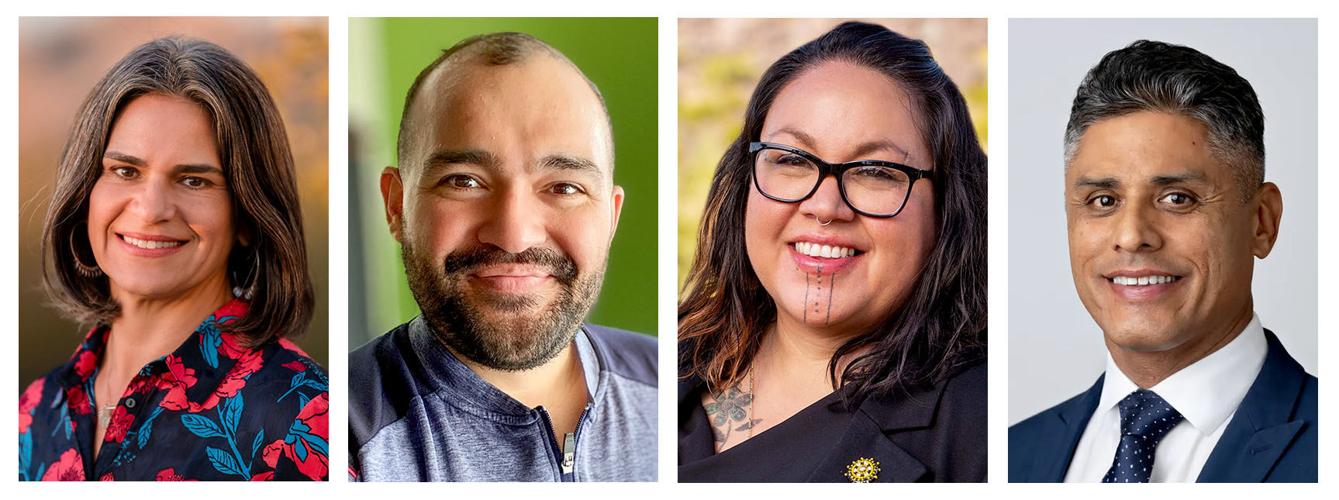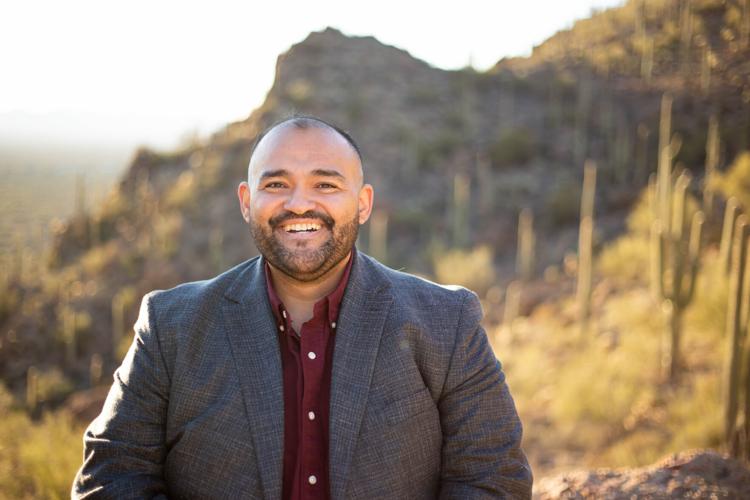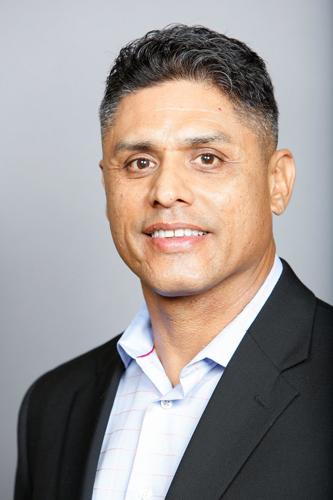Four Democrats are vying for an open seat on the Pima County Board of Supervisors.
Jennifer “Jen” Allen, Miguel Cuevas, April Hiosik Ignacio and Edgar Soto are competing in the July 30 primary to face Republican JL Wittenbraker and Iman-Utopia Layjou Bah, an independent, in the November general election for the District 3 seat.
Supervisor Sylvia Lee is not seeking the post. Lee was appointed to the board in December after long-time supervisor Sharon Bronson resigned, citing a fall and health issues.
District 3 is the county’s largest; it covers about 7,400 square miles in the western part of the county and shares about 130 miles of international border with Mexico. If it were a state, District 3 would have a larger footprint than Connecticut and Delaware, according to U.S. Census data.
The Democratic candidates mostly agree on what are the major issues in the district: roads, the environment, affordable housing and the border. But they differ on how to address them.
Roads
Allen: She would improve transportation routes and options within District 3 by pushing for the RTA to include projects in the district’s urban areas, as well as infrastructure development so outlying communities would be less-reliant on traveling back and forth to Tucson for basic needs.
“We need to think about multiple uses and layering development within communities so that it’s in greater proximity to some of the human needs that those have,” she said to a crowd during the June 29 Democratic primary debate.
Cuevas: “All roads lead to Tucson,” Cuevas said. “It’s evident that the county roads in District 3 have not been prioritized.”
He says that is shows in their general condition as well as a lack of resources being dedicated to roads in the district in the county’s budget.
If elected, Cuevas said he would push for authorization of RTA Next, which is supposed to go out to voters by this time next year, which “is going to be incredibly important where we’re going to have to balance urban, but also rural infrastructure.”
Ignacio: The county is not doing enough in its many unincorporated areas. Too often, she said, community members living in small towns, villages or unincorporated communities within the county are responsible for maintaining their own roads.
Ignacio said living in rural Pima County gives her a better understanding of problems like transportation that her primary opponents don’t have. If elected, Ignacio said she would work to bring elected officials out to these communities by establishing town halls so priorities can be heard.
Soto: A high priority for the public is congestion relief, safety improvements and multimodal options to promote regional connectivity. These projects should be prioritized by RTA Next, he said.
“One of the the things (I hear) talk about is access. Access to get into town, to the grocery store, to their appointments (or) taking their pet to a veterinarian,” Soto said. “We need to realize that this growth is coming, and we can’t deny it, but we need to make sure that we do these (improvements) in a very strategic way, and in a way that’s going to disrupt these areas in the least amount possible,” he said.
Environment
Allen: District 3 “epitomizes the beauty and the resilience” of the Sonoran Desert which residents call home. If elected, Allen says she would fight to maintain access for residents to District 3’s various national parks.
“My background from when I worked for the Western Shoshone Defense Project was focused on environmental protection, even when I did the early years of the Border Action Network, was also focused around environmental protection,” she said. “(Land conservation) is something that’s incredibly important to me.”
Allen said that she would work to root out invasive species such as buffelgrass or stinkweed from District 3 areas, which pose a fire danger, and then go onto “figure out to conserve, literally, every drop of water” if she is elected.
“I think that there are ways we can harvest rainwater, utilizing recycled water, reclaimed water, more effectively. And then there’s just laying off growth,” she said. “We have to think about land use with a real critical eye towards sustainability as it relates to land, water and climate, and how we can sustain ourselves for the long-term and thinking multiple generations out.”
Cuevas: This is an issue of development; both in terms of supporting fast-growing places like Marana, while keeping untouched county lands the way they are, Cuevas said.
“First off, we need to look at what’s already developed and determine, are we using that area properly? And the second part is supporting the growth of Marana, supporting the growth of that area is going to be crucial for the next phase of Pima County’s economy,” he said.
“But then also swing to the Tucson Mountains, it’s going to be incredibly important that we protect that area from unnecessary building, and we keep it in its pristine condition,” he said. “It’s going to be a balance of making sure that we look at each situation and really align it towards the values of the Board and the county residents to make sure that we are continuing to be protectors of the Sonoran Desert.”
Ignacio: “I’m not someone who has to learn about the environment because of where I grew up, and because it’s something that is instilled in tribal children,” she said.
Ignacio says the county will have to factor in current policies that are driving outward development, and how future growth may impact the natural resources of District 3. She said the two-decade old Sonoran Desert Conservation Plan is due to be “reassessed” using more timely data and circumstances.
“I think we just need to revisit it and maybe update some of the (conservation plan)” because climate change is happening before our very eyes,” she said. “A report that came out that Governor Hobbs is not going to stop the idea of Interstate 11 coming through ... and the communities there have been opposing the development of I-11 since its inception.”
When factoring in the necessary development District 3 areas, Ignacio said more community input should be required in any decisions going forward.
Soto: The endorsement from former District 3 supervisor Sharon Bronson has inspired him to follow in her footsteps when it comes to the environment. Bronson was key to the development of the Sonoran Desert Conservation Plan.
“What (Bronson) did that is unique from a lot of elected officials is that she listened to her people. She didn’t go over there telling them what they needed or how they need to do something, she went there and listened ... people knew that she was always there to listen first,” Soto said. “Along those lines, I’m going to do exactly what she did. I’m going to listen to my constituents, and I’m going to advocate for what they want... it’s going to be what the people that live in those communities, in those areas, they feel would help them.”
Soto points to the Santa Cruz River restoration efforts at the Pima Community College’s Desert Vista campus as experience that prepared him for this role. If elected, Soto said, he would opt for an approach similar to his predecessor: working with communities, organizations and other county stakeholders to make sure the environment is “here for generations to come.”
Affordable housing
Allen: Allen says she would try to strengthen the county’s Regional Affordable Housing Commission by working with District 3 municipalities to promote the advancement of more affordable housing.
“The answer is we need more housing. We’ve got a housing gap in (Tucson) of more than 22,000 affordable homes. We need to build affordable homes, but we also want to make sure that we are doing it in a way that is consistent with some of the values that are really important to us... And we’ve got to make sure that we do it in such a way that it’s affordable,” Allen said.
To create more affordable housing options, Allen said if elected, she would prioritize infill methods within Tucson and look for further solutions “utilizing density in how we build.”
A large portion of housing in District 3 are mobile homes, Allen says, which are inefficient when it comes to handling the elements, she said
If elected, Allen said that she would expand weatherization programs and look to establish “co-op models” for mobile home parks so residents can own the land and have more control over it.
Cuevas: As a first-generation homebuyer, he says that boosting affordable housing stock in District 3 is crucial because “it’s part of the American Dream.”
“The other part is that this actually begins to change generational wealth,” he said. “This gives an opportunity for individuals who did not own to be able to get ahead and get into the middle class.”
Cuevas said that there are a few factors that are affecting the county’s affordable. Among them are homebuyers who are purchasing properties only to turn them into short-stay rentals, like Airbnb’s. To deter these “bad actors” from flipping more properties, Cuevas said, he would look to ensure proper zoning regulations are in place so the housing supply can continue to grow.
It is important to make sure the county has the right incentivizes to encourage construction of more houses and apartment complexes, he said.
If elected, Cuevas said he would first want to make sure the county’s housing first initiative is “at the scale that it needs to be.” If not, he’d seek additional funding opportunities to get people into stable, affordable housing.
Ignacio: “I recently moved into public housing two years ago, and it’s the first time I’ve ever had hot water, and the first time I’ve ever had central air conditioning,” she said. “I am more than honored and feel like ... my story is a lot more relatable to the people in District 3, and because of my human connections and the relationships I’ve been building my entire life.”
Ignacio, who works for the Tohono O’odham Nation’s tribal housing program, said that it’s completely “doable” for the county to build low-income housing through grants that are funded through the state, such as the Low-Income Housing Tax Credit (LIHTC) program to boost its affordable housing stock. If elected, this is something she would look to continue pursuing, she said.
It’s crucial to ensure that Pima County zoning commissioners make sound decisions when determining the ability of developers, Ignacio said. If elected, she said she would fight to ensure that the people who are appointed to the zoning commission “are able to make sound decisions when they’re greenlighting an area for development.”
Soto: He said this issue is less about homelessness and more about a crisis of substance abuse and mental health. If elected, Soto said he would look for solutions that have worked in other cities across the country, like in Sacramento, he said, where the city reformed zoning regulations to increase urban density, Soto said.
“Whether it’s streamlining the permitting process or you give incentives for affordable housing developments ... You can include certain breaks, or get grants or density bonuses, these kinds of things can help,” he said. “You need the housing first (approach) with the support, you can’t just give someone a house. You’ve got to have that support and wrap-around services to help them get there.”
Soto said that if elected he would try to seek public-private partnerships with developers so building affordable housing in Pima County is incentivized.
Border issues
All four candidates said immigration and Pima County’s ‘border crisis’ stems from federal policy, and that Pima County and its taxpayers should not be saddled with trying to fix the problem.
Allen: It’s necessary for the next Pima County District 3 Supervisor to have a deep understanding of the border for this position, Allen said. She pointed to her tenures with the Western Shoshone Defense Project and the Border Action Network as examples of her expertise on border issues. Allen said that she would continue taking federal funding to alleviate the strain that immigration has on Pima County.
Cuevas: He says he supports the county’s efforts so far in their endeavor at the border, and that supporting asylum seekers should come at no cost to county taxpayers. Like his opponents, Cuevas said if elected as supervisor, he would push the board to continue accepting federal dollars so that it doesn’t fall on county taxpayers.
Ignacio: The conversation about the border is a bit “ironic,” Ignacio says, noting she’s the only Native candidate and that the Tohono O’odham Nation straddles Arizona and Sonora since well before the U.S.-Mexico border was established.
But the conversation around the border is still one that needs to be re-centered, she said.
“As the only Native American candidate, I would be remiss if I don’t take that opportunity to remind people that this entire country was built on the backs of indigenous and black people, and so I find it offensive sometimes when migrants are categorized with the offensive language,” Ignacio said. “The narrative is that traffickers and migrants are the same. These are two separate issues ... The humanitarian piece (is) completely missing from the conversation.”
Soto: Even though it’s due to a broken federal policy, the county should continue accepting federal dollars to process asylum seekers. Because if the county stops, Soto said, the cost and burdens of this issue will fall to the county taxpayers.
Like his opponents, Soto said the county should continue accepting and administering federal funds to local organizations and county departments to alleviate the strain immigration has here.
</&h5>
</&h5>
</&h5>
</&h5>








